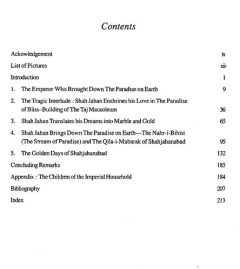Shah Jahan and His Paradise on Earth transports us to Shah Jahan's Hindustan where every aspect of life, socio-political, architectural and cultural had reached the pinnacle of glory. The author highlights the Shahjahani era as the golden period of Mughal rule because the salient features of good governance which characterized the rule of the great Mughals seem to have attained their fulfillment under the able rule of Shah Jahan where a balance was struck between Shariat and rules of good governance, where justice was assured to all, where efficiency was the criterion for preference. This, with the hierarchical system of governance evolved by the Mughals, created a most effective administrative machinery. The Umaras of Shah Jahan were gifted men who excelled in efficiency, in military skill and administrative acumen, in wit, refinement and learning. The general ambience of refinement and culture permeated into the zenana mahal as well, where worthwhile lives were led. Shah Jahan was the undisputed master of a realm stretching from Afghanistan to Assam in the north and almost the whole of the Deccan in the south, in which trade, commerce and agriculture flourished, law and order prevailed. This could be a picture of Shah Jahan's "Paradise" in the figurative sense. But there is another side to it. Shah Jahan's claim that he had brought down the "Paradise" on earth rested on his belief that the cities he founded, the gardens he laid out, the grand edifices he erected were paradisiacal in beauty and perfection. Vandalism and ravages of time have detracted from his creations much of this beauty and perfection, making his claim in some cases rather hyperbolical. The author seems to have taken upon herself the task of vindicating Shah Jahan's claim by recapturing the untarnished beauty of some of these creations on the basis of contemporary accounts. Her description is so vivid and lucid as to make us feel we are seeing the Taj Mahal in the process of construction and then visiting it in its pristine beauty. We can almost visualize the Agra palace when the imperial family occupied it, witnessing the gala wedding ceremonies and other celebrations there. We are also given a glimpse of the Peacock Throne. We see Shah Jahan's new capital, Shahjahanabad, visualize the grand thoroughfares with the Nahr-I-Bist flowing through the middle of them, the majestic Jama Masjid, the grand city gates and the Red Fort in all its grandeur and almost hear the music of the drum-house. The book opens with a biographical sketch of Shah Jahan containing intimate personal touches and closes with an account of his dear children. Based mainly on translated Persian texts, this is an informative and well-written book containing some interesting illustrations.
Shah Jahan and his Paradise on Earth: The Story of Shah Jahan Creations in Agra and Shahjahanabad in the Golden Days of the Mughals
In stock
Free & Quick Delivery Worldwide
reviews
Bibliographic information
Title
Shah Jahan and his Paradise on Earth: The Story of Shah Jahan Creations in Agra and Shahjahanabad in the Golden Days of the Mughals
Author
Edition
1st ed.
Publisher
K P Bagchi & Company, 2007
ISBN
8170743001
Length
xiv+218p., Plates; Notes; References; Bibliography; Index; 30cm.
Subjects







There are no reviews yet.